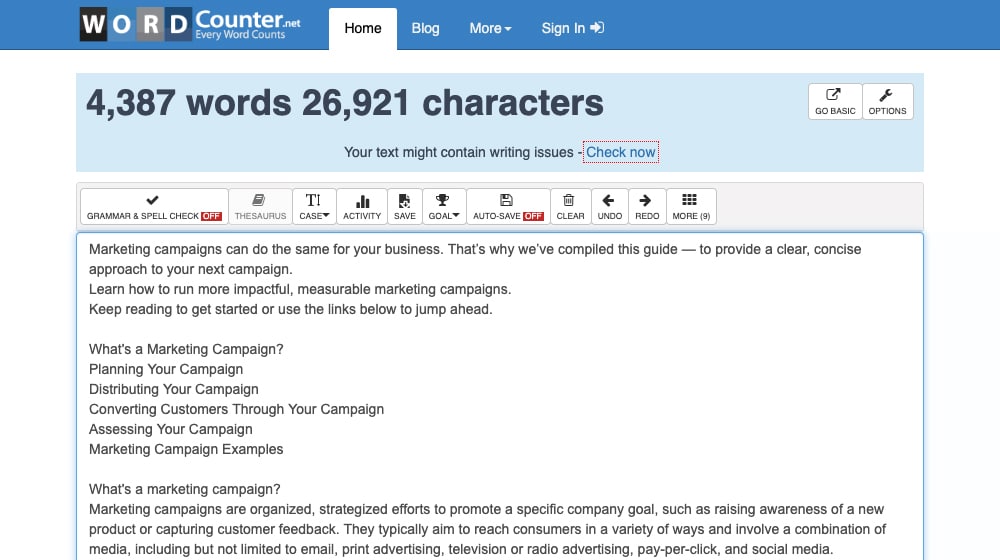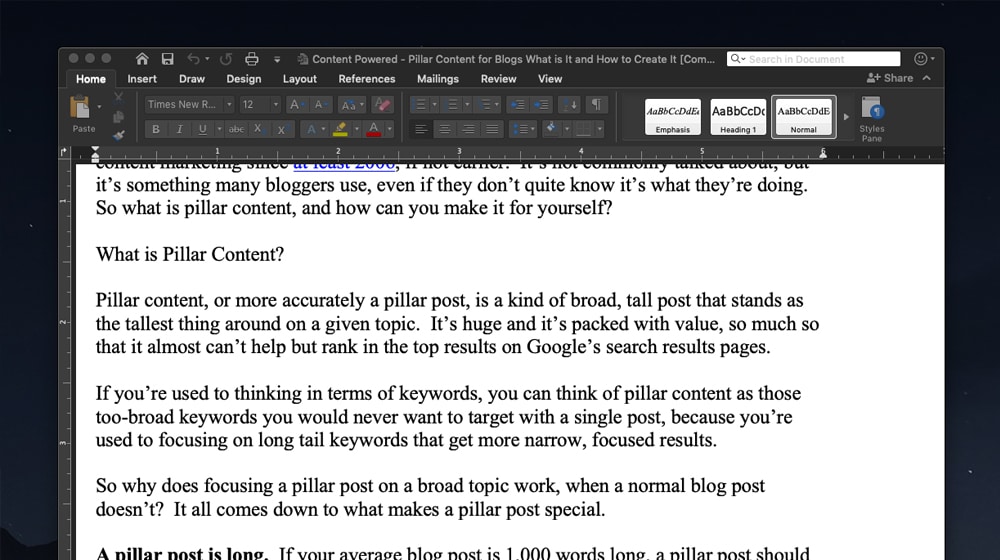What Is A Content Pillar
0:00 Listen to audio podcast

Pillar content, also called cornerstone content, is a term that has been thrown around in content marketing since at least 2006, if not earlier. It's not commonly talked about, but it's something many bloggers use, even if they don't quite know it's what they're doing. So what is pillar content, and how can you make it for yourself?
What is Pillar Content?
Pillar content, or more accurately a pillar post, is a kind of broad, tall post that stands as the tallest thing around on a given topic. It's huge and it's packed with value, so much so that it almost can't help but rank in the top results on Google's search results pages.

If you're used to thinking in terms of keywords, you can think of pillar content as those too-broad keywords you would never want to target with a single post, because you're used to focusing on long tail keywords that get more narrow, focused results.
So why does focusing a pillar post on a broad topic work, when a normal blog post doesn't? It all comes down to what makes a pillar post special.
A pillar post is long. If your average blog post is 1,000 words long, a pillar post should be at least 2,500. If your average blog post is 2,000 words long, a pillar post should be 4,000 or more. I've seen pillar posts that end up looking like small eBooks or ultimate guides instead, and that's perfectly fine.

A pillar post is broad. You don't want to go TOO broad with it, of course. Trying to write one singular post on "social media marketing" is far too broad and too varied to be a pillar post. Conversely, a post on "retweet marketing" is too narrow to make a good pillar. Somewhere in the middle, you can find "Twitter marketing" and make THAT your pillar post. Why do you want it to be so broad? Because:
A pillar post is a hub. A pillar post covers a topic in broad detail, but it doesn't dig deep into every single sub-sub-topic. For a Twitter marketing post, it will cover in broad strokes topics like the different types of retweets, using Twitter ads, Twitter trends, reply etiquette, Twitter's new kinds of reply restrictions, and so on. Any topic related to Twitter marketing you can think of can have a paragraph in your pillar post dedicated to it. Possibly even several paragraphs!
You can think of a pillar post like the hub in the middle of a wheel. That hub is connected to the outer wheel with spokes. Those spokes are your narrow, long-tail keyword targeted blog posts. Each of those topics, covered in the pillar post in a few short paragraphs? Somewhere in that paragraph is a link to a blog post you write, covering the topic in greater detail.
A pillar post is kept up to date. You want your pillar post to be a hub of value and knowledge. That means keeping it up to date. For example, if I had an old post about tips on how you can write a tweet in 140 characters, that post is no longer relevant since Twitter increased their character limit to 280. This presents me with a choice: do I update the old post, write a new post, or remove the topic from the pillar post?
The third option is rarely the best. Usually, it's a good idea to write new content on the topic. If the old post has a lot of links and traffic, though, it might be a better idea to update it instead.
Pillar content is better. Rand Fishkin from Moz also calls this type of content "10x content", because it's "content that's 10x better than the highest ranking result for a given keyword."

As such, pillar content requires you to have awareness of what already exists in that space. You're creating a real ultimate guide, a true comprehensive resource, and to do that you need to know what already exists out there. You need to find holes in information, and be able to provide that information.
Now You're Thinking with Topics
One of the keys to creating good pillar content is thinking in terms of topics rather than keywords. I've been a proponent of this for a while, and other marketers are slowly coming around to my way of thinking. Neil Patel is another herald of the concept, having written posts like Why You Shouldn't Do Keyword Research for Your Blog Posts espousing the idea.

So what do I mean? Think about how you use search engines as a casual user. When you look for something, are you thinking about the keyword you need to type in to find the information you want? Probably, because you're a marketer. Normal people, though, they don't have the first clue of how SEO works. All they know is they can ask Google a question and they can get an answer.
It used to be that using Google took a certain amount of developed skill. You had to know how to formulate a query the right way, so the Google robots could understand it and give you the right information.
From the marketing side of things, you had to guess what kind of query the user was going to formulate to find information, and target that specific query – those keywords – with your content.
Google has spent a lot of time and effort over the last decade trying to provide this service to users in a better, more open way. Many users experienced frustration when the queries they typed in never seemed to get the right answers.
Google's updates with machine learning and semantic parsing have all but eliminated the need to care about specific query formulas. Semantic Search allows Google to use context to serve more accurate results. BERT further optimizes this. Meanwhile, it's easier than ever for users to simply ask Google a plain-language question through a helper like Google Home and get accurate results.
Don't get me wrong; keywords are still useful to guide your content creation. Perform your keyword research. You still get to see the actual kinds of queries people are using to find content, and can use that knowledge to improve your own content.
However, when creating pillar content, you don't want to limit yourself to specific keywords. You're not going to be focused enough on any one keyword to rank well for it alone. Pillar content is meant to focus on the entire, broad topic, and be such a good resource for everything related to that topic that it's impossible for it not to rank.
Examples of Pillar Content
Want to see pillar content in action? It's not very impressive. The reason, of course, is because you see it every day, even if you don't recognize it for what it is.
WebMD is one huge example of pillar content done well. Every time you search for any sort of medical term or disease, you're going to find a WebMD piece of pillar content on the subject.

Let's use "gum disease" as an example. If I told you to write a piece of content about gum disease, you might go through the keyword research process and decide that, say, you should write a blog post about the symptoms of gum disease, or the treatments for gum disease, or the differences between gum disease and gingivitis. Those are three different articles, you think, with narrow audiences, but focused results.
Here's their example: the WebMD page for gum disease.
This article covers the difference between gum disease and gingivitis, the causes and symptoms of gum disease, how it's diagnosed and treated, how it can be prevented, and other concerns you may have about the disease. All in one post.
The post is deep and detailed, but it's also full of links to other related content, including content that digs deeper into individual topics it mentions.
WebMD has a ton of content on their site that is not this kind of pillar content, but you know what? Unless you actually browse through their site, you might not ever see it. Pillar content dominates the search results. It has some competition from sites like Healthline doing the same thing, but narrower pages never make the cut.
To use a more marketing-focused example, there's always Brian Dean's Backlinko post on Google's 200 ranking factors.

This is a huge top-level guide. It covers basically everything you could ever want to know about Google's search ranking factors, both the ones that Google tells us about and the ones that we only know about through experimentation and data monitoring. The thing is, every single factor on that list has a couple of sentences at most describing it.
The trick is, most of those factors also have a link in them that leads to a post on the subject, dedicated to that one search ranking factor. Some of those links are to Backlinko content, but many of them are to other high-ranking sites or first-party sources, like Google themselves.
What this means is that if you have any question at all about any search ranking factor, this post is probably going to show up. Other posts might have better information about that specific factor, but this post is going to appear somewhere, because it has so much overall value that even if the keyword is only a passing mention, it's still valuable.
How to Create Your Own Pillar Content
Pillar content is obviously a great strategy for ranking in the search results, but it also seems like a ton of work. How can you do it yourself? Well, you're right about one thing; it's a lot of work.
Start with topic ideation. I like the spiderweb or snowflake method of brainstorming ideas, if you're familiar with those concepts. Basically, you start with your core industry in a bubble, something like "marketing" in broad strokes. Then you spin off tier 2 topics within that topic, like "content marketing" and "paid marketing" and "social media marketing." Then you pick one of those and spin it off into tier 3 topics. Social media marketing becomes "Facebook marketing" and "Twitter marketing" and "Instagram marketing" and so on.

Tier 3 is about where you're getting narrow enough to be pillar content, but not so narrow that you can't find enough sub-topics to write about. Depending on your starting point, you may go another tier or two deeper, or maybe not quite so deep. For example, a business that specializes 100% in social media marketing might go deeper for a piece of pillar content.
The key to picking this kind of topic is four-fold. It should be:
- Only 2-4 words long. The more words you need to describe it, the narrower it is and the less suited it is to pillar content.
- Specific to your industry. Obviously, you want your pillar content to be relevant to your expertise.
- Educational. Pillar content is rarely going to be a direct tutorial; rather, it's a hub resource for other content.
- Relevant to your business. Your pillar content is attracting users to your website, so you need to be able to do something with that audience.
So let's say I picked "Twitter marketing" as my core concept for the pillar post. Now I need to generate sub-topic ideas, and any sub-sub ideas, and so on down the line. Anything that's worth mentioning can be added here. It can be broader overview topics, like "how to use Twitter ads", or it can be narrow questions a user might ask, like "what does RT mean?"

You can do this with just brainstorming, but this is also where keyword research comes into play. It's always a good idea to know which topics your audience is actually looking for, even if you don't end up using the exact specific keyword phrases.
Remember, pillar content needs to be long. It's going above and beyond your normal blog post length. The more sub-topics you can brainstorm, the better off you'll be, because the less you need to write in your pillar post to cover everything and end up with a longer post.
Decide how you-centric the pillar post should be. I've shown you two examples of the two extremes up above. The WebMD example is almost entirely self-contained. Every link in their pillar posts is to another WebMD post, unless it's directly to an authoritative source for actual medical information. Conversely, the Backlinko post links to a wide variety of different guides, articles, and sources, with very few other links to Backlinko itself.
Personally, I prefer somewhere in the middle. Call it about a 50/50 split between internal and external links. I will happily acknowledge when someone else has written content on a topic that's better than what I have, or that covers a segment of the topic I haven't covered before. I'll link to them… and then I'll get to work out-doing them with my own content.
The more you-centric you want your pillar post to be, the more content you need to write to link to within it. If you don't already have a substantial blog with content already written on those subjects, you're going to need to take the time and get to work.
Get to work creating content. My general process looks like this:
- Start building the broad outline of the pillar post. Basically, just writing down the headline, subheadings, and topics in each section. This doesn't need to be detailed; it's just here to guide you and help you create flow and structure to the pillar post.
- Look for any content you've already written and published on that topic. This includes both on your domain and on others, such as if you wrote a good guide you published as a guest post.
- Look for any top-tier content already existing for the topics you haven't already covered. If there are posts out there you absolutely don't think you can out-do, go ahead and resign yourself to linking to them for now. You can always try to write your own version later.
- Start filling in the gaps. Any topic that you haven't covered, and that you don't find existing great content for, you can write a post to cover. Publish that post and link to it in your pillar post outline.
- Flesh out the pillar post outline. For sections where you don't have a link yet, spend a little more time writing about it. You can retroactively add the link later.
You can see now why creating a good pillar post takes so much time, eh?

Publish and promote your pillar post. Publishing it is easy, but you do want to make sure you're optimizing it as much as you can for the overall topic. Focus on making a compelling headline, a great and optimized set of meta data, and so on. Bonus points for making it a special URL that's not part of your blog, so it's easy and memorable.
Promoting your pillar post will be an ongoing project. You want to link to it anywhere you can. This is a huge piece of content, an emblem of what your company can produce. Put it in your email signature, give it a special button in your navigation, link to it in guest posts and on social media, do anything you can to keep it circulating. You don't need it to go viral, but you do need it to be there, waiting, watching, all the time.
Keep it evolving and growing. This is the key to a good pillar post. It's never done. New industry news? Add a relevant section to your pillar post. Old topic changes and is no longer valid? Update the old post – or write a new one – and edit the relevant section in your pillar post. Think of a new topic you want to cover? Add a new section. Make sure to update the post occasionally just to keep a "last edited" date within the last few months at all times.
And that, my friends, is how you make a killer pillar.
What Is A Content Pillar
Source: https://www.contentpowered.com/blog/pillar-content-how-create/
Posted by: fabriziotwoured.blogspot.com

0 Response to "What Is A Content Pillar"
Post a Comment